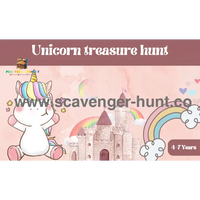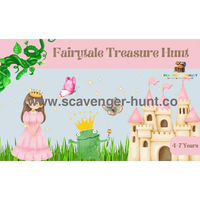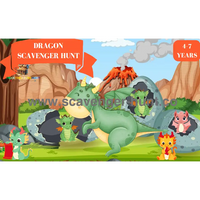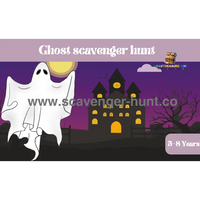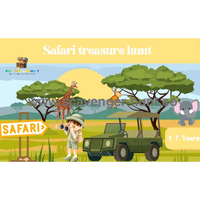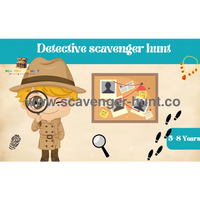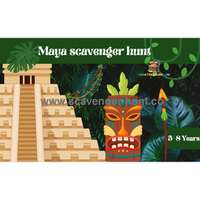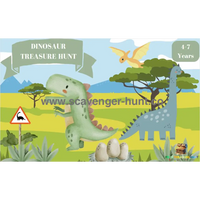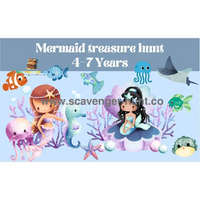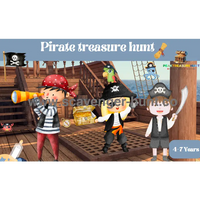Planning a treasure hunt for kids is a fun and engaging way to entertain them, whether it's for a birthday party, a family gathering, or just a weekend activity. Here are the steps to plan an exciting and memorable treasure hunt:
Step 1: Choose a Theme
Select a Theme: Begin by picking a theme that aligns with the kids' interests. This could be anything from pirates, a jungle adventure, superheroes, to a fairy-tale quest. A well-chosen theme can greatly enhance the excitement and engagement of the treasure hunt.
Here are some examples for popular treasure hunt themes:
- Pirate Adventure
Description: Embark on a swashbuckling adventure with a pirate-themed party. Decor includes treasure chests, pirate flags, and maps. Activities could involve a treasure hunt, walking the plank, and costume contests. Ideal for those who love adventure and mystery.
- Enchanted Fairy Tale
Description: Transform your venue into a magical fairy tale world. Think castles, fairy lights, and enchanted forests. Guests can dress as their favorite fairy tale characters. Activities might include storytelling, a magic show, and a royal ball dance.
- Superhero Showdown
Description: A superhero-themed party where guests come dressed as their favorite comic book heroes and villains. Decorations can be vibrant, featuring iconic symbols and cityscapes. Activities could include superhero training courses and photo booths with props.
- Hollywood Glamour
Description: Roll out the red carpet for a Hollywood-themed party. Guests dress in glamorous attire, and decorations mimic the glitz of Hollywood with gold stars, movie posters, and velvet ropes. Include a photo backdrop and award trophies for various fun categories.
- Under the Sea
Description: Dive into an underwater-themed party with oceanic decor like coral, seashells, and mermaids. Use blue and green lighting to create an aquatic ambiance. Activities might include a sea creature scavenger hunt and crafting seashell decorations.
- 80s Retro Rewind
Description: Travel back in time with an 80s-themed party. Think neon colors, leg warmers, and big hair. Play iconic 80s music, and have retro arcade games or a dance-off contest. Encourage guests to dress in 80s fashion for a nostalgic trip.
- Fiesta Fun
Description: Host a vibrant and colorful Mexican fiesta. Decor includes bright colors, sombreros, and piñatas. Serve traditional Mexican cuisine and have activities like salsa dancing lessons and a piñata bash.
- Casino Royale
Description: Create a sophisticated casino atmosphere with card games, roulette wheels, and slot machines. Decor can include red, black, and gold colors with playing card and dice motifs. Offer 'play money' for guests to gamble and exchange for prizes.
- Garden Tea Party
Description: Perfect for an elegant outdoor celebration, featuring floral arrangements, pastel colors, and vintage tea sets. Serve a variety of teas, finger sandwiches, and pastries. Activities can include hat decorating or a floral arrangement workshop.
- Space Odyssey
Description: Explore the cosmos with a space-themed party. Use dark colors with starry and planetary decor. Activities could include a planetarium show, astronaut training games, and making model rockets.
Each of these themes offers a unique experience, transporting guests into different worlds and sparking their imagination. Whether you’re planning a child’s birthday party or an adult gathering, these themes can be tailored to suit any age group and occasion.
Incorporate Theme Elements: Use the chosen theme to guide every aspect of the treasure hunt. This includes the creation of clues, the design of the treasure map, and even the type of treasure. The more the elements of the hunt reflect the theme, the more immersive the experience will be for the children.
Step 2: Plan the Course
Select a Location: Decide on where the treasure hunt will take place. This could be within your home, in a backyard, at a local park, or even in a specific room, depending on the size of the group and the age of the kids.
- Local Park
Description: Public parks offer expansive space and diverse environments. They have different areas like playgrounds, ponds, and wooded sections, which are great for hiding clues. This setting is ideal for large groups and outdoor enthusiasts.
Here are some examples for popular treasure hunt locations:
- Backyard
Description: A backyard treasure hunt is perfect for a more intimate or family-oriented event. You can use garden features, like flower beds, small sheds, and trees as hiding spots for clues. This location offers convenience and safety, especially for hunts involving younger children.
- Beach
Description: A beach provides a scenic backdrop for a treasure hunt. Use natural landmarks like dunes, rocks, or driftwood as clue locations. The expansive sandy area allows for a wide-ranging hunt and is perfect for incorporating water-based clues.
- House or Apartment
Description: Indoor treasure hunts can be a blast, especially in larger homes or apartments with multiple rooms. Use furniture, books, and home decor as clever hiding spots. This location is ideal for rainy days or winter events.
- Neighborhood
Description: For a more extensive hunt, use your entire neighborhood. Clues can be placed at local landmarks, parks, or friendly neighbors' front yards. Ensure safety and supervision, particularly in busier areas or for hunts involving younger children.
- Forest or Nature Reserve
Description: For a more adventurous hunt, consider a local forest or nature reserve. Natural features like streams, unique trees, and rocks make excellent spots for clues. This location is best for older children or adults due to the more challenging terrain.
- Historic Downtown
Description: Utilize the unique features of a historic downtown area, like statues, old buildings, and local monuments. This setting is ideal for creating a hunt with a historical or educational twist.
- Museum
Description: A museum can offer an educational and entertaining setting for a treasure hunt. Use exhibits, artworks, or informational plaques as parts of your clues. This location is ideal for a quieter, more intellectually stimulating hunt.
- Shopping Mall
Description: A mall can be a fun and unexpected place for a treasure hunt. Use store fronts, food courts, and common areas as clue locations. This setting is great for teens or when you want to combine the hunt with shopping or dining.
- Farm or Orchard
Description: Farms or orchards provide a rustic setting for a treasure hunt. Use elements like barns, farm equipment, and different types of trees or plants as part of your clues. This location is perfect for a nature-themed hunt.
Each location offers unique opportunities and challenges for a treasure hunt. When choosing a location, consider the age of participants, the size of your group, and safety requirements to ensure a fun and successful adventure.
Scout the Location: Before the day of the hunt, visit the chosen location to scout out potential spots to hide clues and the final treasure. Look for spots that are safe yet challenging enough to keep the kids intrigued.
Step 3: Create Clues
Write Clues: Tailor the clues to the age group of the children. For younger kids, picture clues or simple riddles are ideal. For older children, more complex riddles or puzzles can be used to add a challenge.
Creating engaging and clever clues is essential to a successful treasure hunt. Here's a list of sample clues that can be adapted to various environments and themes:
Make Clues Visible: Place the clues where they are visible enough for the kids to find, but not too obvious. The goal is to strike a balance between being challenging and achievable.
Step 4: Design a Treasure Map
Draw a Map: Depending on the age of the children and the complexity of the course, create a simple map that leads to each clue or directly to the treasure. This can add an element of adventure and make the hunt more engaging.
Add Creative Elements: To make the map more interesting, add creative elements like burnt edges or tea-stained paper to give it an ‘authentic’ treasure map look.
Step 5: Decide on the Treasure
Choose the Treasure: The treasure can be anything from a box of treats, small toys, or books, to certificates for accomplishing the hunt. Choose something that you know the children will be excited about.
The treasures in a treasure hunt are the exciting finale, the reward for all the hard work of deciphering clues. Here's a list of popular treasures that can bring joy and satisfaction to the participants:
- Assorted Sweets and Chocolates
-
Description: A classic and universally loved treasure, especially for children. A mix of various candies and chocolates can be a delightful reward.
- Custom Medals or Trophies
-
Description: Personalized medals or trophies give participants a sense of accomplishment and something to remember the event by.
- Toy Assortment
-
Description: Small toys like action figures, puzzles, yo-yos, or stuffed animals. Great for kids' treasure hunts.
- Books
-
Description: For a more educational reward, age-appropriate books can be both exciting and beneficial for young participants.
- Craft Kits
-
Description: DIY craft kits or art supplies encourage creativity and provide an additional activity for after the hunt.
- Themed Goodies
-
Description: Items that match the theme of the treasure hunt. For instance, pirate-themed hunts could have eye patches, gold coin chocolates, and miniature flags.
- Gift Cards
-
Description: Suitable for older children or adult treasure hunts. Gift cards can range from bookstores to online shops.
- Nature-Inspired Treasures
-
Description: For outdoor hunts, consider items like polished stones, shells, or plant seeds. They can be both interesting and educational.
- Puzzle Boxes
-
Description: Small puzzle boxes which require solving to open can be an intriguing reward, possibly containing another clue or a small trinket.
- Personalized Notes or Certificates
-
Description: A heartfelt note of congratulations or a personalized certificate of achievement can be a meaningful treasure, especially when coupled with other small rewards.
- Homemade Treats
-
Description: Cookies, cupcakes, or other homemade treats can be a sweet and personal reward.
- Tech Accessories
-
Description: For a tech-savvy crowd, small tech accessories like USB drives, earbuds, or phone cases can be exciting finds.
- Movie or Event Tickets
-
Description: Tickets to a movie, concert, or sports event can be a thrilling treasure for participants of all ages.
- Miniature Board Games
-
Description: Small, portable board games or card games that can be enjoyed by participants later.
- Adventure Coupons
-
Description: Coupons for fun activities like a trip to the zoo, an amusement park, or a day at a climbing gym.
Consider Group Dynamics: If you're hosting a group of children, ensure there's enough treasure for everyone. The treasure can also be something that encourages sharing among the kids.
Step 6: Hide the Clues and Treasure
Strategic Hiding: Hide the clues and the treasure in the pre-selected locations. Ensure they are placed in safe areas that are accessible for the children.
The hiding spots for treasure hunt clues can greatly enhance the excitement and challenge of the game. Here's a list of creative and interesting spots to hide clues:
- Inside a Book
-
Description: Tuck a clue between the pages of a book. Choose a book that is relevant to the theme of the hunt or frequently used.
- Under a Flower Pot
-
Description: Hide a clue underneath a flower pot. Ensure it’s a pot that can be easily moved without damaging the plant.
- In a Mailbox
-
Description: Place a clue inside a mailbox. This is an easy-to-find yet often overlooked spot.
- Inside a Cookie Jar
-
Description: For kitchen-themed hunts, hiding a clue in a cookie jar can be a sweet surprise.
- Behind a Picture Frame
-
Description: Slip a clue behind a picture frame on the wall. Choose a frame that's at an accessible height for participants.
- Under a Park Bench
-
Description: If the hunt is outdoors, a clue can be discreetly placed under a park bench.
- In a Puzzle Box
-
Description: Use a small puzzle box to hold the clue. Participants need to solve the puzzle to access the clue.
- Inside a Glove or Mitten
-
Description: Tuck the clue inside a glove or mitten, especially for hunts during colder seasons.
- In the Pocket of a Hanging Coat
-
Description: Hide a clue in the pocket of a coat hanging in the entranceway or closet.
- Amongst Stuffed Animals
-
Description: For kids' hunts, place a clue amidst a pile of stuffed animals.
- Under a Rock or Fake Rock
-
Description: In garden or outdoor settings, hide a clue under a rock or a strategically placed fake rock.
- Inside a DVD Case
-
Description: Place the clue in a DVD case, preferably a movie or show related to the theme of the hunt.
- Taped Under a Table
-
Description: Secure a clue underneath a table where it’s not immediately visible.
- Inside a Cereal Box
-
Description: For a playful indoor hunt, put a clue inside a cereal box.
- In a Birdhouse
-
Description: If there’s a birdhouse in the yard, it can be a quaint hiding spot for a clue.
- Inside a Shoe
-
Description: Hide a clue inside a shoe, preferably one that's not in regular use.
- With a Sibling or Friend
-
Description: Have a person be the clue keeper. Participants need to approach them and possibly perform a task to receive the clue.
- In a Music Instrument Case
-
Description: If there’s a musical instrument in the house, use its case as a hiding spot.
- On a Windowsill
-
Description: A clue can be subtly placed on an inside windowsill, perhaps hidden behind a curtain.
- Inside an Umbrella
-
Description: Tuck the clue inside a closed umbrella, especially if it's for an indoor hunt.
Sequential Order: Arrange the clues in a sequential order so that each clue leads to the next, building up to the final treasure location.
Step 7: Explain the Rules
Give Clear Instructions: Before starting the hunt, explain the rules to the kids clearly. Let them know what they are looking for and how to interpret the clues.
Safety First: Especially if the hunt is in a large or outdoor area, set safety boundaries and rules. Ensure the children understand where they can and cannot go.
Step 8: Start the Hunt
Kick-off: Begin the hunt by giving the kids the first clue or the map. This marks the start of their adventure.
Supervise: Throughout the hunt, keep an eye on the children, offering help if they get stuck and ensuring they stay safe.
Step 9: Conclude the Hunt
Celebrate the Find: Once the treasure is found, celebrate the kids' success. You can organize a small ceremony or a round of applause to acknowledge their effort.
Debrief: Talk to the kids about the hunt, asking them what they enjoyed most and what they found challenging. This can be a great way to wind down and shift to the next activity.
Step 10: Post-Hunt Activity
Wind Down: After the excitement of the hunt, engage the kids in a calm activity. This could be a story session, snack time, or a craft activity related to the theme of the hunt.
Organizing a treasure hunt requires some planning, but seeing the excitement and joy it brings to children makes it all worthwhile. Each step contributes to creating an unforgettable adventure for them.
Remember, the key to a successful treasure hunt for kids is to keep it fun, age-appropriate, and safe. The joy is in the adventure and the excitement of discovery!

















